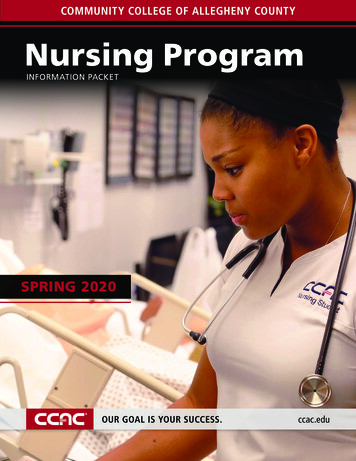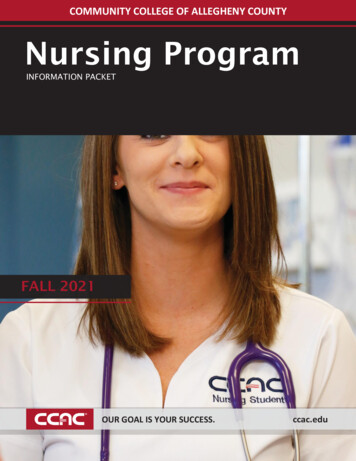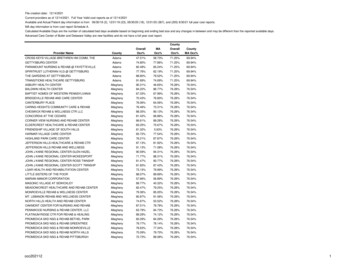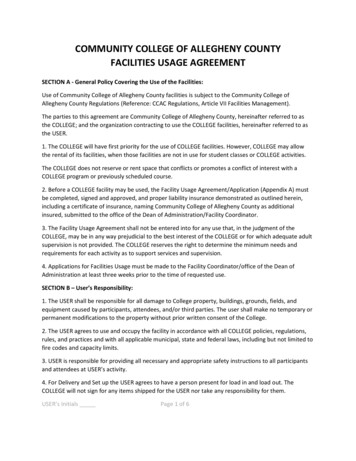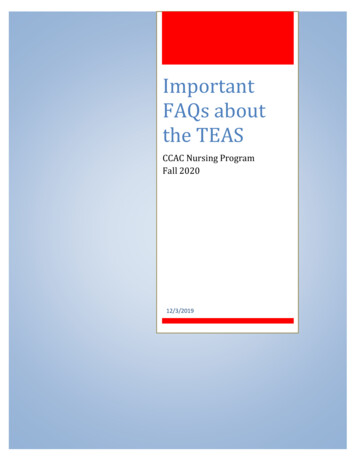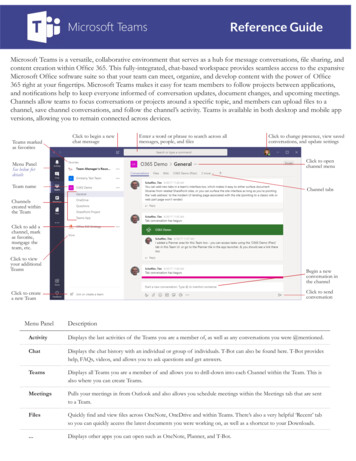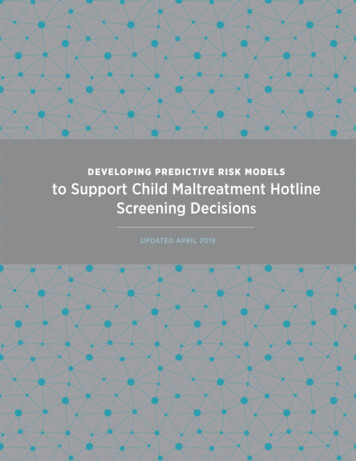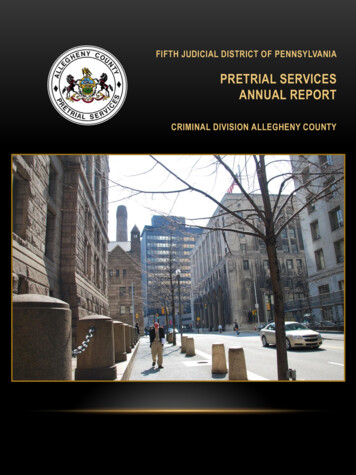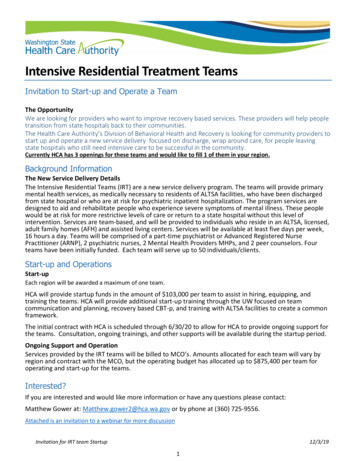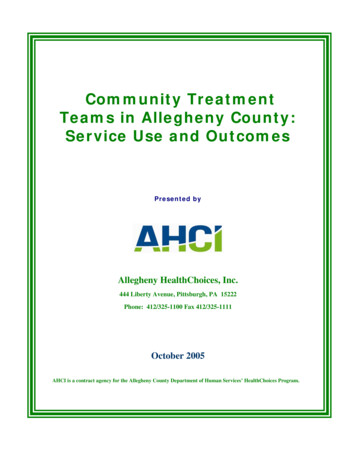
Transcription
Community TreatmentTeams in Allegheny County:Service Use and OutcomesPresented byAllegheny HealthChoices, Inc.444 Liberty Avenue, Pittsburgh, PA 15222Phone: 412/325-1100 Fax 412/325-1111October 2005AHCI is a contract agency for the Allegheny County Department of Human Services’ HealthChoices Program.
About HealthChoices and AHCIHealthChoices, Pennsylvania's managed care program for Medicaid, provides physical healthcare and behavioral health care services to both children and adults. The goals of Pennsylvania'sHealthChoices program are to improve: Access to services;Quality of care;Continuity of the care provided in a multi-system environment; andCoordination and distribution of finite Medical Assistance resources.Under HealthChoices, Allegheny County contracts with the Commonwealth of Pennsylvania toimplement the behavioral health services portion of the program. Allegheny County hasdelegated responsibilities for managing the behavioral health program to two other organizations: The County contracts with Community Care Behavioral Health Organization(Community Care) to manage behavioral health services for the HealthChoices program. Allegheny County also contracts with Allegheny HealthChoices, Inc. (AHCI) to carryout the County’s oversight and monitoring responsibilities required under theHealthChoices program.This report is one of a series published by AHCI as part of its oversight and monitoringresponsibilities. All AHCI reports can be downloaded from our Web site at www.ahci.org. Formore information or additional copies of this report, please visit our Web site, contact us byphone at 412.325-1100, or email eheberlein@ahci.org.
Allegheny County Community Treatment TeamsTABLE OF CONTENTSTable of Contents . 1Executive Summary . 2Introduction . 4Who Do Teams Serve?. 7Age, Gender and Race . 7Geography. 7Diagnosis. 9Psychiatric Hospitalizations and Community Tenure. 11Summary and Discussion. 12Services Used by CTT Consumers. 13Time-unlimited Services . 14Intensive and Comprehensive Services. 16Crisis Interventions . 20Other Behavioral Health Services. 21Summary and Discussion. 23Consumer Outcomes . 24Community Tenure . 24Community Psychiatric Hospitalizations. 25State Mental Hospitalizations . 27Jail Days. 29Community Tenure and Costs. 30Housing . 31Employment . 33Education . 36Other Supports . 36Summary and Discussion. 38Recommendations . 39Appendix . 40Other Sources of Information on the ACT Model and CTTs . 40Notes on Cost Calculations used in Table 8. 40Crisis intervention categories. 40Housing status categories. 41Employment categories. 41Non-behavioral health supports categories . 41References . 43Allegheny HealthChoices, Inc.1
Executive SummaryEXECUTIVE SUMMARYCommunity Treatment Teams (CTTs) provide community-based, comprehensive, and intensivemental health and addiction treatment to persons with serious and persistent mental illnesses inAllegheny County. CTTs go beyond helping consumers to manage the symptoms of their illnessto supporting consumers in defining their hopes and goals and pursuing their personal recovery.The four Allegheny County CTTs are designed to follow the Assertive Community Treatment(ACT) model, an evidence-based practice in behavioral health treatment. Evidence-basedpractices (EBPs) are treatments that have demonstrated positive treatment outcomes in scientificresearch studies.Through the end of March 2005, the four Allegheny County CTTs have served 390 consumers.This report examines data structured to follow the CTT consumers’ experiences on the teams overtime. Team staff provided assistance in interpreting the data. AHCI staff also spent time withvarious staff members to gather further insight and input. Findings include:Consumer characteristics. Enrollment on community treatment teams is targeted for consumerswith serious and persistent mental illnesses who have not benefited from more traditional types ofservices. Most of the consumers on the four Allegheny County CTTs have a diagnosis ofschizophrenia, bipolar disorder, or major depression/depressive disorders, which are appropriatefor participation on teams. Consumers enrolled on teams commonly have histories of long-termor frequently recurring psychiatric hospitalizations in state or community facilities and/or cooccurring substance abuse disorders.Services used by CTT consumers. CTTs are designed to be intensive, long-term communitybased behavioral health services. The teams have been very successful in providing long-termservices to consumers. Teams have experienced relatively few discharges. Because CTTs workwith consumers who have generally not engaged with or benefited from traditional services, thisretention in treatment is a very positive outcome. However, teams have not yet enrolled theexpected number of total consumers (currently 100 consumers per team, based on a ratio of tenconsumers per one staff member).Tools for measuring how well teams follow the ACT model indicate that a team operating in fulladherence to the model will provide, on average, two hours of service per consumer per week,and, on average, four face-to-face contacts per week. Individual consumers will receive more orless than this average, based on their individual need.Teams are meeting the targeted number of service hours for each consumer per week. However,the teams are falling short of the goal of four contacts, on average, per consumer per week. Notall consumers need four contacts with the CTT per week (some will need more contacts, whileothers will require fewer contacts). There is concern that some consumers have received veryfew services per week and the teams do not appear to be receiving and responding to the expectednumber of mobile crisis interventions. High staff turnover has certainly been a factor.Consumer Outcomes. Research has demonstrated that ACT model programs have led toincreased community tenure (time spent in the community), improvements in consumers’ housingstability, and increased independent living. Also, when specifically incorporating a vocationalcomponent, CTT programs can also lead to positive employment outcomes for many consumers.The Allegheny County CTTs should be commended for their work in helping consumers stay outof the hospital and live independently:2Allegheny HealthChoices, Inc.
Allegheny County Community Treatment Teams In the six months preceding their enrollment with CTT, consumers spent an average of 63%of their days in the community. In their first six months with CTT, consumers spent anaverage of 75% of their days in the community. After consumers have been with CTT formore than one year, consumers spent an average of 85% of their days in the community.During the first six months on CTT, hospitalization costs decreased 28% compared to preCTT. During the second six months on CTT, hospitalization costs decreased 51% whencompared to pre-CTT. For later periods, hospitalization costs remained 64% to 70% belowpre-CTT costs.Overall, many CTT consumers experienced positive outcomes related to their housing statusby either maintaining independent living status or moving toward more independent housing.Even with these positive outcomes, the data analysis and discussion with teams indicate servicedelivery, and consequently consumer outcomes, could improve further. While many consumersdo not get admitted to the hospital or spend time in jail, there are opportunities to increasecommunity tenure, primarily through the reduction of community hospitalizations. Also, theteams have identified several shortfalls in available housing, which limit consumers’ abilities tomove to less restrictive settings. Furthermore, the majority of consumers has not madeimprovement toward employment and has not developed supports outside of the CTT.Recommendations based on the analysis and follow-up discussions include:1. Technical assistance is needed in managing a CTT caseload on a daily basis. Dataanalysis indicates that some consumers receive small amounts of service, and teams are notproviding the recommended average amount of contacts with consumers. The teams haveprovided their perspective on barriers to providing more frequent or intensive services. Thesebarriers need to be assessed further and solutions implemented in order to insure overallservice provision meets the standards of an ACT program.2. Training and technical assistance is needed to implement other best practices within theACT model. Teams would benefit from training in implementing dialectical behaviortherapy, dual diagnosis treatment and supportive employment best practices within the teams.3. Teams must work to follow the ACT model. The teams must be staffed with specialists(substance abuse, vocational, peer, and forensics). The specialists need to be trained in theirspecialties and given time to focus on these areas with consumers. Furthermore, teams musttake the time to complete individualized assessments, crisis plans and treatment plans.Focusing on housing, vocational and supports goals is essential for consumers as they movetoward recovery.4. System barriers need to be addressed. Teams and consumers have identified unmethousing needs. Hopefully, the implementation of the Allegheny County Office of BehavioralHealth Permanent Supported Housing Strategic Plan will help meet some of these needs.Peer programs also should be supported by the system and funds for activities should besecured. Finally, teams have limited influence in diverting hospital admissions. Inpatientunits need to be educated on CTTs. More proactive and direct communication between teamstaff, Community Care, and inpatient units must be instituted to allow CTTs to takeresponsibility for diversions.In order to implement these recommendations, AHCI, the County and Community Care need todevelop a detailed plan to support and monitor the teams. As the plan is implemented, datareports should be used to develop priorities and interventions. CTTs provide an essential servicewith positive outcomes demonstrated extensively in research. The teams need to be trained,supported, monitored and held accountable if we are to expect continued and additional positiveoutcomes in Allegheny County.Allegheny HealthChoices, Inc.3
IntroductionINTRODUCTIONCommunity Treatment Teams (CTTs) provide community-based, comprehensive, and intensivemental health and addiction treatment to persons with serious and persistent mental illnesses inAllegheny County. The goal of CTTs is to help people stay out of the hospital and develop skillsand supports to lead meaningful lives in the community. CTTs go beyond assisting consumersmanage the symptoms of their illness to support consumers in defining their hopes and goals andpursuing their own personal recovery.The four Allegheny County CTTs are designed to follow the Assertive Community Treatment(ACT) model, an evidence-based practice in behavioral health treatment. Evidence-basedpractices (EBPs) are treatments that have demonstrated positive treatment outcomes in scientificresearch studies.An extensive body of research providesevidence that CTT participation leads tomore positive consumer outcomes thanother forms of treatment. The mostconsistent finding in CTT researchinvolves hospital use. In a review of theliterature published in 2001, Bond et al.described 17 studies in which CTTconsumers experienced a signficiantreduction in hospital admissions andlengths of stay. See the Appendix forother sources of information on the ACTmodel.What does the research show?Assertive Community Treatment (ACT) hasdemonstrated numerous positive outcomesincluding: Retention in treatmentFewer hospitalizations and hospital daysIncreased community tenureImproved housing stability and increasedindependent livingPositive employment outcomesWhile studies have been inconclusive regarding the effect of CTT participation on the amount oftime consumers spend in jail (Lewin Group 3), the sizeable decrease in time spent in mentalhospitals has significantly increased the average time consumers spend in the community. Thisincrease in community tenure is important from a quality-of-life perspective as well as inconsiderations of cost effectiveness. Though CTT services are fairly expensive, they are still lesscostly than hospitalizations (Essock 179).Research has also demonstrated ACT model programs have led to improvements in consumers’housing stability and increased independent living (Mueser et al. 37). When specificallyincorporating a vocational component, CTT programs can also lead to positive employmentoutcomes (Becker 104).While the effects of CTT treatment on other outcomes have been studied to a lesser degree,available research also indicates such treatment can lead to positive effects on such factors asengaging and retaining consumers (Herinckx et al. 1304) and addressing co-occurring substanceuse disorders (Drake et al. 201).When programs are designed to follow the model used in the research cited above, the samepositive treatment outcomes can be expected. Following the ACT model is therefore veryimportant. The Allegheny County CTTs are monitored both in treatment outcomes and in howwell they follow the model. Key aspects of the ACT model include: Flexible, assertive, and intensive community-based services. CTT services areprovided by team members who are on-call 24 hours per day, seven days per week, and365 days per year. Staff increase or decrease duration and frequency of contacts with4Allegheny HealthChoices, Inc.
Allegheny County Community Treatment Teamsindividual consumers based on consumer needs. Seventy-five percent or more of theservices provided by the teams should occur in the community (i.e., outside the CTToffice). The teams work proactively with consumers to help them engage in treatment,live independently, and move through the recovery process. Comprehensive, long-term services. The teams provide a wide array of services directlyto consumers, including psychiatric evaluations, mental health and drug and alcoholtherapy, medication management, case management, peer support, assistance withhousing, crisis and hospital diversion services, vocational assessments and supportedemployment, and assistance in managing personal finances. Multidisciplinary staff. To provide these comprehensive services, the CTTs mustoperate as a multidisciplinary team. The teams therefore include a Team Leader, PeerSupport Counselors, a Psychiatrist, Nurses, Mental Health Professionals, Drug andAlcohol Specialists, and Vocational Specialists. The expected ratio is one team memberto ten consumers with a total capacity per team of 100 to 120 consumers. Both of thesefactors allow the teams to provide most services with minimal referrals to other servicesor providers.Allegheny County currently has four CTTs.Mercy Behavioral Health, Residential CareServices, and Western Psychiatric Instituteand Clinic each operate a team for adultconsumers. Western Psychiatric Institute andClinic also operates a team for transition-ageconsumers (ages 16-25 years). CommunityCare Behavioral Health pays for the servicefor consumers who are enrolled in MedicalAssistance, and Allegheny County Office ofBehavioral Health pays for the service forconsumers not eligible for MedicalAssistance. Community Care manages allauthorizations and referrals, regardless ofwhether Community Care or AlleghenyCounty pays for the service.“CTT saved my life”M. believes that he would have died livingon the street without CTT. While he wasresistant to the team at first, they wereable to help him get into rehab to treat hisalcoholism and find him a place to live.M. is now the house manager of a soberliving house and has maintained hissobriety for many months.M.’s experience and appreciation of CTTare far from unique. When consumersare asked to explain how CTT helpedthem, consumers talk about the teams’assistance in finding housing and helpingthem meet their daily needs. Consumerstalk about their trust in staff, and howaccessible the team is (especially thepsychiatrists, when compared to otherservices). They value staff’s ability to seethem quickly in the community, and staff’spersistent efforts to reach consumers.The Allegheny County CTTs beganaccepting referrals late in 2001, and haveserved 390 consumers from 2001 through theend of March 2005. This total number ofconsumers includes both individuals stillinvolved in the teams and those who havebeen discharged. While 81% of the consumers who have been enrolled in CTT treatmentcontinue to receive services, 19% of the consumers have been discharged from the program or aredeceased.This report examines the CTTs from the perspective of the consumers’ experiences on the teamsover time. Rather than focusing on a specific year of teams’ operations, the data is presented interms of the time consumers have spent on the teams, and changes they have experienced whileon the teams.Allegheny HealthChoices, Inc.5
IntroductionThis report examines three areas: CTT consumer characteristics. CTTs are designed to serve consumers with specificdiagnoses, histories, and service needs. Therefore, examining the population served onthe Allegheny County teams can show if Allegheny County CTT consumers are similarto clients served in other ACT programs. Services used by CTT consumers. CTTs are expected to provide comprehensive andfrequent services for consumers. Services used by CTT consumers are examined in thiscontext. Consumer outcomes. When the model is followed, it is expected that programs willdemonstrate the positive outcomes associated with the ACT model. In this report,community tenure (time spent in the community), housing, employment, education, andnon-behavioral health supports are examined to develop an understanding of consumers’progress over time.The report includes data from the year prior to consumers’ enrollment with a CTT through March30, 2005. A number of different data sources were used in the development of this report,including: HealthChoices claims. Providers submit claims for payment to Community Care for theservices they have provided to consumers. The claims that are approved and paid byCommunity Care are included in this report. Both CTT and non-CTT services areconsidered. County service utilization records. Service utilization for behavioral health services(both CTT and non-CTT services) funded by the County are included in the report. Admissions data. Admissions data for community psychiatric hospitalizations and statemental hospitalizations are analyzed in the report. CTT application data. Each CTT is responsible for tracking changes in a variety ofdomains through an online database. Input from team staff and consumers. AHCI staff visited each CTT and shared datawith team staff. The teams provided very helpful input. Also, AHCI staff spent timewith various staff members in the field to gather further insight and input.AHCI would like to thank all of the CTT staff and consumers who provided their feedback duringthe development of this report.A note about reporting termsThe mean and the median are measures most commonly used to describe a group’scharacteristics. The mean is the result of adding up all the observations, then dividing by thenumber of observations. If the data is skewed (meaning there are a few extremely high or lowvalues, in comparison to most values), the mean will be pulled up or down by these extremevalues. In these cases, the median may provide a more accurate description. The median is themiddle value in the group. Half of the values in the group fall above the median, and half thevalues fall below the median.6Allegheny HealthChoices, Inc.
Allegheny County Community Treatment TeamsWHO DO TEAMS SERVE?The four Allegheny County CTTs have served 390 consumers since they began in late 2001.This section summarizes the demographic characteristics of these consumers, including age,gender and race, and their distribution around the County. Diagnoses and hospitalizationhistories are also described.Age, Gender and RaceOver time, each team has served between 91 and 102 consumers. The mean age for consumers attime of enrollment on the three adult teams has been 43.9 years, with a range of 23 to 84 years.For the consumers on the WPIC Transition Team, the mean age at enrollment has been 21.7years. Chart 1 illustrates the overall gender and racial mix of the consumers who have beenenrolled in the four CTTs.Chart 1Gender and Race of Consumers Enrolled inAllegheny County CTTs1%21%Female AfricanAmericanFemale Caucasian32%Female OtherMale African American24%Male CaucasianMale Other21%1%GeographyThe CTTs have served consumers throughout Allegheny County. Of the 317 currently activeconsumers (through March 2005), 159 or 59% live within the City of Pittsburgh. Many CTTconsumers live in the city neighborhoods of East Liberty, Point Breeze/Homewood, and theSouth Side Slopes. Outside of the city, a large number of consumers reside in municipalities suchas Wilkinsburg, Millvale, and Bellevue. Additionally, many consumers currently reside inMayview State Hospital in the municipality of Bridgeville. The following map shows theaddresses of consumers currently enrolled on teams.Allegheny HealthChoices, Inc.7
Who Do Teams Serve?Location of Consumers and CTT OfficesBecause the majority of CTT contacts are expected to take place in the community, it is importantfor staff to have geographic accessibility to consumers’ homes. Based on the most recentaddresses of active consumers, the following table illustrates the number of consumers livingwithin 1 mile, 5 miles, and 10 miles of their team offices.8Allegheny HealthChoices, Inc.
Allegheny County Community Treatment TeamsTable 1Proximity of Consumers to CTT OfficesActiveConsumers# of cons.within 1mile ofoffice% of cons.within 1mile ofoffice# of cons.within 5miles ofoffice% of cons.within 5miles ofoffice# of cons.within 10miles ofoffice% of cons.within 10miles %WPIC Adult75811%5776%6283%WPIC Trans.8068%4050%6075%Total317248%17856%24477%The distance between residence and office does not necessarily reflect the time required to travelbetween the team offices and consumers’ residences.However, it does provide anapproximation. It should be noted that: 44% of active consumers live more than five miles from their team offices 23% of active consumers live more than ten miles from their team officesDiagnosisCTTs are designed to provide intensive community-based treatment for consumers with seriousand persistent mental illnesses who have not benefited from more traditional behavioral healthservices. As such, teams have predominantly enrolled consumers with a primary diagnosis ofschizophrenia or other psychotic disorders, or a chronic, major mood disorder. The followingchart shows the primary diagnosis of CTT consumers based on the most frequently receivedprimary diagnosis found on a consumer’s claims record.Chart 2Diagnoses of Consumers on CTTs15%SchizophreniaBipolar D/O9%51%Maj DepressionDepressive D/O7%4%Unspec PsychosisConduct D/O3%11%Allegheny HealthChoices, Inc.Other9
Who Do Teams Serve?The most common diagnosis for consumers is schizophrenia (51%), followed by bipolar disorder(15%) and major depression/depressive disorders (16%, combined). Because of their youngerage, consumers on the WPIC-Transition Team have a different diagnostic pattern, with someconsumers having conduct and adjustment disorders. When this team is excluded, 62% of theconsumers on the three adult teams had a primary diagnosis of schizophrenia and 27% had aprimary diagnosis of bipolar disorder or major depression/depressive disorder.Research has shown that as many as 50% of individuals with serious mental illnesses willdevelop a co-occurring substance use disorder at some point during their lives (Surgeon General’sReport). Determining an accurate count of the number of consumers with co-occurring substanceuse disorders on the CTTs using claims or authorizations data is difficult.* According to theCTTs, the majority of CTT consumers have substance use disorders. For example: Based on a review of their current caseload, the Mercy Team estimated that 75% of theirconsumers have a co-occurring substance use diagnosis. The WPIC-Transition Team estimated that closer to 50% of their consumers havesubstance use issues. The WPIC Adult Team estimated that 60% to 65% of their consumers have a cooccurring substance use diagnosis. In fact, the primary diagnosis for some consumers haschanged over time. For example, as consumers have addressed their substance abuseissues, the team has determined that previously received mental health diagnoses ofpsychosis-related disorders are not appropriate (e.g., psychotic symptoms occur onlywhen the consumer is abusing drugs or alcohol).By all reports, the substance abuse issues are significant and impact treatment greatly. Each teamis required to include one substance abuse counselor for each 50 consumers on the team to insurethat the teams have the expertise and capacity to provide substance abuse treatment.The teams also think that Axis II diagnoses, which are not captured in claims data, stronglyinfluence consumers’ success on the teams as well as their utilization of services. For example,some CTT staff has cited particular challenges in working with consumers who have borderlinepersonality disorders or traits.Other ACT programs have added specific treatment components, notably dialectical behaviortherapy (DBT), to work with people who have borderline personality disorder diagnoses or traits.Managing this specific therapy program within the structure of an ACT team is challenging, butcan be very successful if implemented consistently. Based on the difficulties the teams reporthaving with people in this diagnostic subcategory, they would benefit from additional trainingand technical assistance in this area.*Using care management data from Community Care, consumers can be counted as having a co-occurringsubstance use disorder if they ever had a documented substance use diagnosis for any episode of treatmentwhile in the HealthChoices program. This only includes consumers whose CTT ser
Teams in Allegheny County: Service Use and Outcomes Presented by Allegheny HealthChoices, Inc. 444 Liberty Avenue, Pittsburgh, PA 15222 Phone: 412/325-1100 Fax 412/325-1111 October 2005 AHCI is a contract agency for the Allegheny County Department of Human Services' HealthChoices Program.
